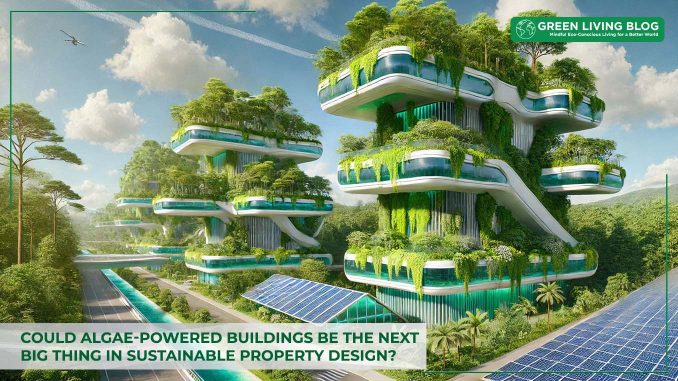
Sustainable property designers are coming up with some incredibly exciting ideas about how to make the architecture of the future more energy efficient.
One of the most recent developments is the introduction of algae-powered buildings, where algae bioreactors are integrated into the property design.
This may sound like a strange idea, but there have been numerous studies that point to it potentially being revolutionary.
Buildings with algae bioreactors can currently save up to 30 per cent on energy costs, and this figure is likely to increase after future developments in this niche.
Discover how to grow algae to get a better understanding of the process:
What Are Algae-Powered Buildings?
Algae-powered buildings do exactly what they say on the tin – harness the power of algae and use it to make energy for the property. This is done using an algae bioreactor, which cultivates microalgae in transparent tubes in the building’s façade. They take in sunlight, carbon dioxide, and water to perform photosynthesis. From that, they produce biomass and oxygen as by-products.
The biomass can then be converted into biofuels, and the act of photosynthesis itself removes a lot of CO2 from the atmosphere. This means that algae bioreactors create a carbon-negative system that also allows building inhabitants to enjoy clean air. There are a few examples of this technology in use already, with the BIQ House in Hamburg, Germany, among the first of its kind.
Beyond Algae: Other Biological Innovations
The amazing thing about algae is that it’s completely sustainable, and, in theory, this type of property design could exist forever. There have also been a few other nifty biological innovations in recent times, highlighting the growing impact scientific advancements are having on the green property market. One great example of this is the moss-based wall, which can be used to improve air quality and reduce noise pollution, thanks to its cushioning effect.
There’s also the integration of mycelium, which is the root structure of fungi. This is being used as a biodegradable insulation material, with many benefits to this method. Along with having a low carbon footprint, panels made from mycelium are cheap and offer insulation that is on par with traditional methods.
Another interesting biological phenomenon scientists are currently exploring is bioluminescent lighting. There are various creatures that give off this form of light, and now researchers are trying to figure out if it can also be harnessed for lighting in homes.
There may soon be genetically engineered algae and bacteria that can be used as a sustainable alternative to current lighting methods.
Discover more about how bioluminescence found in nature works:
Can Algae Bioreactors Increase a House Value?
For people considering switching to algae-powered solutions, the main concern may be the impact on property value. Is the idea of this strange weed on their property going to put off potential buyers? Or could it instead boost the house’s value? The good news is that homes that incorporate sustainable solutions are more popular than ever, so an algae-powered building is likely to be a plus point for some buyers.
Indeed, if you try to sell your home to cash home buyers, they can also ask about any sustainable features in your home to help inform their property valuation. This is because they sometimes sell properties on to other businesses for up-front cash, and these buyers will be aware of the growing interest in the green property market, making your home easier to sell.
What Does the Future Hold for Algae-Powered Buildings?

Although algae-powered buildings do show a lot of promise, there’s still a lot of work to be done before they can become a mainstream solution. Currently, the installation cost of algae bioreactors is high, so further innovation is needed to ensure that this technology can be rolled out on a mass scale. There’s also the fact that algae bioreactors need regular upkeep, so more people will have to be trained in performing repair and maintenance works.
Algae-powered buildings clearly represent a massive leap forward in the sustainable property market, as well as helping to blur the lines between nature and architecture. The fact that these properties benefit both the environment and the humans living within them is a win-win situation and should encourage long-term adoption. Hopefully, these recent developments in the green architecture space will inspire more scientists to get involved and help advance this technology, to enable it to be integrated into more homes.
![]()
Author Profile
- Online Media & PR Strategist
- Blogger and Educator by Passion | Senior Online Media & PR Strategist at ClickDo Ltd. | Fascinated to Write Lifestyle Blogs in News & Education I have completed a journalism summer course at the London School of Journalism and manage various blogs.
Latest entries
 BusinessOctober 29, 2025Top 6 UK Government Green Funds & Grants for SMEs
BusinessOctober 29, 2025Top 6 UK Government Green Funds & Grants for SMEs List postOctober 16, 202510 Best Green Hosting Services in the UK
List postOctober 16, 202510 Best Green Hosting Services in the UK BusinessSeptember 9, 2025Top 5 Eco Certifications & Their Impact on Greener Businesses
BusinessSeptember 9, 2025Top 5 Eco Certifications & Their Impact on Greener Businesses LeisureSeptember 2, 2025Plant-Power: The UK’s Top 10 Vegan Festivals 2025
LeisureSeptember 2, 2025Plant-Power: The UK’s Top 10 Vegan Festivals 2025






Leave a Reply
You must be logged in to post a comment.